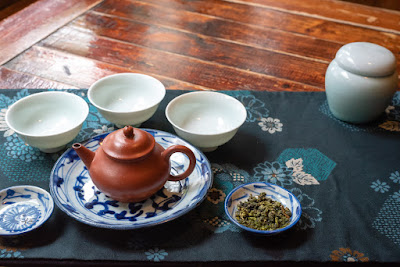From the sight of the brew, these 3 Oolongs also look very similar. They are all processed in a fresh high mountain Oolong style. Are you ready for the results?
 |
| Left and middle are from overseas and the one on the right is from Alishan, Taiwan |
The difference of origin is actually most noticeable in the brew's scents and taste. The spring Alishan has all the finesse, lightness and freshness of spring. The 2 imported feel much more like summer or fall Oolongs. Their aromas are not as fresh and their taste feels more astringent and bitter. Apparently, they didn't grow in the same cool conditions as in Taiwan's high mountains!
There's a difference, but how significant it is depends on how sensitive and experienced you are. So, like for overseas OB, I have purchased enough of these overseas high mountain Oolongs to give away 5 gr samples for those purchasing at least 30 USD worth of high mountain Oolong from my boutique (1 sample per order as long as my inventory lasts).
 |
| TianChi qingxin Oolong from winter 2018 |
This Oolong was shining brightly in the celadon cups on this turquoise Chabu! A 3 stars tasting it was.











3 comments:
Hi Stéphane, I can skip the sample of imported tea, because I already know that I would like your Taiwan HM more!
I did want to comment, though, on the beautiful colours of your Chaxi. That deep turquoise, paired with the red earth colour of an Yixing teapot, is an exquisite combination. Add the various other blues, one goldfish and the red wood surface... and you're almost painting!
So lovely!
Elisabeth
Hi Elisabeth,
Yes, the colors came out particularly well in this tea house, even on a cloudy day. You'll see one of these pictures again in another project!
Thanks for the comment and kind words.
Stephane
I just tried the non taiwan oolong sample. The first infusion was actually not too bad- very buttery aroma that tricked me into thinking this was going to be good. The taste was a bit sour but not too much. However, second infusion was much more sour and bitter. Third infusion was almost undrinkable. After one sip of fourth infusion, i dumped rest into garbage. Leaves had very long stems. This was educational. Thank you for sample. I think i had similar tasting tea before from a mall vendor in taiwan that sold it as long feng xia.
Post a Comment